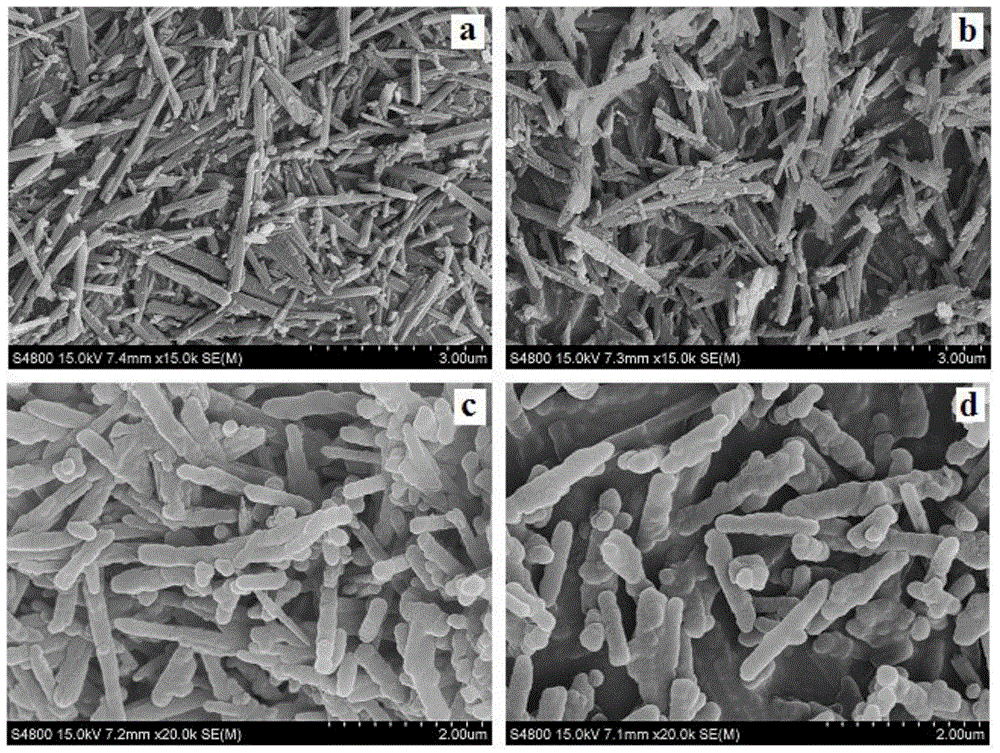Method for controllably preparing hollow molecularly-imprinted nanorod by using halloysite as template
A molecular imprinting and halloysite technology, applied in nanotechnology, chemical instruments and methods, and other chemical processes, can solve problems such as control, uniformity and thickness of difficult-to-polymerize layer coating, and achieve excellent regeneration performance, abundant reserves, The effect of good thermal and chemical stability
- Summary
- Abstract
- Description
- Claims
- Application Information
AI Technical Summary
Problems solved by technology
Method used
Image
Examples
Embodiment 1
[0029] (1) Halloysite pretreatment and surface functionalization
[0030] According to the ratio of halloysite (HNTs):concentrated nitric acid:distilled water mass ratio of 1:4:25 (g / g / g), halloysite, distilled water and concentrated nitric acid were added to the flask in turn, ultrasonicated for 30 min, and placed in 80 o In a C oil bath, stir vigorously for 12 h, filter with suction, wash with distilled water until neutral, and place at 100 o C oven drying to constant weight, to obtain the processed halloysite. According to the ratio of treated halloysite: 3-(methacryloyloxy) propyltrimethoxysilane (KH570): toluene mass ratio is 1.0:1.0:100 (g / g / g), to the three-necked flask Add treated halloysite, 3-(methacryloyloxy)propyltrimethoxysilane and toluene in sequence, ultrasonically disperse evenly, place at 90 o In a C oil bath, the reaction was vigorously stirred for 12 h. After the reaction, cooled to room temperature, the product was washed with toluene, ethanol and disti...
Embodiment 2
[0036] (1) Halloysite pretreatment and surface functionalization
[0037] According to the ratio of halloysite (HNTs): concentrated nitric acid: distilled water mass ratio of 1:6:25 (g / g / g), halloysite, distilled water and concentrated nitric acid were added to the flask in sequence, ultrasonicated for 30 min, and placed in 80 o In a C oil bath, stir vigorously for 12 h, filter with suction, wash with distilled water until neutral, and place at 100 o C oven drying to constant weight, to obtain the processed halloysite. According to the ratio of treated halloysite: 3-(methacryloyloxy) propyltrimethoxysilane (KH570): toluene mass ratio is 1.0:1.0:100 (g / g / g), to the three-necked flask Add treated halloysite, 3-(methacryloyloxy)propyltrimethoxysilane and toluene in sequence, ultrasonically disperse evenly, place at 90 o In a C oil bath, the reaction was vigorously stirred for 12 h. After the reaction, cooled to room temperature, the product was washed with toluene, ethanol an...
experiment example 1
[0046] Experimental Example 1: Take 10 ml of chloramphenicol solutions with initial concentrations of 10, 50, 100, 150, 200, 300, 400, 500 and 600 μmol / L and add them to a centrifuge tube, add 10 mg of HMINs-1, For HMINs-2, HMINs-3 and HNINs-2, the test solution was placed in a 298 K water bath for 12.0 h, and the supernatant was collected by centrifugation, and the molecular concentration of unadsorbed chloramphenicol was measured with a UV-visible spectrophotometer , and calculate the adsorption capacity according to the result. Such as Figure 7 As shown, the experimental results show that: with the increase of the concentration, the adsorption amount of chloramphenicol increases; the adsorption amount of chloramphenicol by hollow molecularly imprinted nanorods is greater than that of HNINs-2, showing good specific recognition and separation performance, indicating that there are active sites matching chloramphenicol molecules in the hollow molecularly imprinted nanorod po...
PUM
 Login to View More
Login to View More Abstract
Description
Claims
Application Information
 Login to View More
Login to View More - R&D
- Intellectual Property
- Life Sciences
- Materials
- Tech Scout
- Unparalleled Data Quality
- Higher Quality Content
- 60% Fewer Hallucinations
Browse by: Latest US Patents, China's latest patents, Technical Efficacy Thesaurus, Application Domain, Technology Topic, Popular Technical Reports.
© 2025 PatSnap. All rights reserved.Legal|Privacy policy|Modern Slavery Act Transparency Statement|Sitemap|About US| Contact US: help@patsnap.com



